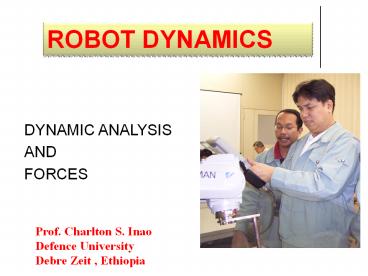Robot Dynamics (1) PowerPoint PPT Presentation
Title: Robot Dynamics (1)
1
ROBOT DYNAMICS
DYNAMIC ANALYSIS AND FORCES
Prof. Charlton S. Inao Defence University Debre
Zeit , Ethiopia
2
Introduction
- Analysis of forces, torques, inertias, loads, and
accelerations. - Derivation of dynamic equations of motion.
- Allows determination of important loads for
design. - Assists in the selection of actuators.
3
Newtonian Mechanics
- Easier for simpler systems.
- Familiar to users
4
Lagrangian Mechanics
- Easier for more complicated systems
- Based on systems energies
- Systematic
- Lagrangian is the difference between kinetic and
potential energies of the system
5
Lagrangian Relationships
- Lagrangian relationships are
6
Review of Basics
- Potential energy is energy stored in an object
due to its position or arrangement. - Kinetic energy is energy of an object due to its
movement - its motion
7
Illustration
8
(No Transcript)
9
Lagrangian Mechanics
- Lagrangian field theory is a formalism in
classical field theory. It is the field-theoretic
analogue of Lagrangian mechanics - Lagrangian mechanics is used for discrete
particles each with a finite number of degrees of
freedom. Lagrangian field theory applies to
continua and fields, which have an infinite
number of degrees of freedom. - Deals with energy.. The difference between
Kinetic and Potential energy.
10
- In this chapter, were going to learn about a
whole new way of looking at things. - Consider the system of a mass on the end of a
spring. We can analyze this, of course, by using
F ma to write downm mx -kx. - The solutions to this equation are sinusoidal
functions, as we well know. - We can, however, ?gure things out by using
another method which doesnt explicitly use - F ma.
- In many (in fact, probably most) physical
situations, this new method is far superior to
using F ma.
11
Lagrangian mechanics
- Please see examples in the book for the
application of Lagrangian mechanics. For the
following system we can derive equations of
motion as
12
Example 1
13
Kinematics Solution
Wangular velocity of the wheel 2rdiameter X
dot linear velocity
14
Dynamics Solution
15
Notes
16
Notes
velocity
distance
17
Example 2
Newtonian mechanics VS Lagrangian mechanics
18
Solution
a) Lagrangian Mechanics
19
b) Newtonian Mechanics
20
(No Transcript)
21
Example 3
22
Solution 3
23
a) KEKE cart KE pendulum
1
24
b) PEPE spring PE pendulum
Pendulum
Spring
25
b.1) PE pendulum
26
LK-P
27
Solution 3 continued
28
Review/Reference
29
Solution 3 continued
30
Example 4 (For home study or work out exercise)
31
Solution 4
32
Solution 4 contd..
33
Solution 4 contd..
34
Solution 4 contd..
35
Solution 4 contd..
36
Taking the derivatives of the Langrangian and
substituting into Equation 4.4 yields to the ffg.
Equation of Motion
37
Equation of motion in Matrix Form
Solution 4 contd..
38
Example 5 (Class Discussion)
39
Solution 5
40
(No Transcript)
41
Solution 5 .. In matrix form
42
DETAILED SOLUTION No. 5
Solve for Kinetic Energy for each link
Solve for K1
43
RECALL
44
Reference Moment of InertiaThin rod about axis
through end perpendicular to length
45
Solve for the X and Y component of M2
Horizontal component up to point m2
vertical component up to point m2
46
(No Transcript)
47
Comcenter of mass
48
(No Transcript)
49
Differentiate XD and YD to get the velocity and
the velocity of the arm distance up to point m2
U r
Vcos?
U V
Recall
50
Calculate the VD ,up to Mass2and square it, for
linear an d angular component of momentum
expression, V2D
51
Solve for K2
K1
K2
52
Solve for K2
Angular momentum
linear momentum
Recall
53
Solve for Lagrangian,L K-P
54
Differentiation with respect to time, in terms of
both variables, i. e. r,?
1st
55
(No Transcript)
56
Differentiation of L with respect to ?
57
(No Transcript)
58
Solve for Lagrangian, K-P
59
Detailed calculation for VD2
60
(No Transcript)
61
(No Transcript)
62
(No Transcript)
63
(No Transcript)
64
(No Transcript)
65
- THE END

